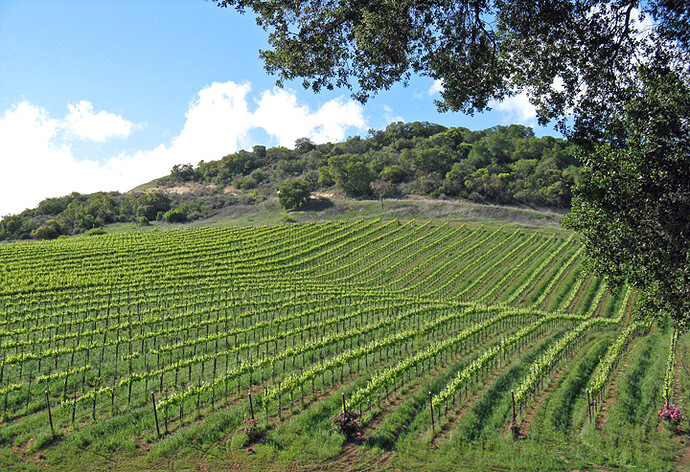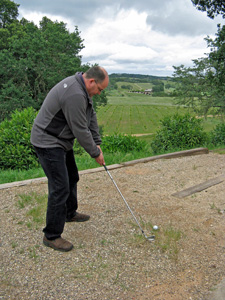A second springtime with no Hospice du Rhône was approaching, and a number of “regulars” who had attended the event for years started corresponding about a possible get-together. We all realized that as much fun as the official seminars and tastings had been, we really missed seeing each other and missed the unofficial yearly events surrounding HdR – the dinners and winery / vineyard tours that we’d always arranged on our own. Since our informal group hailed from all over the country, our annual gatherings at HdR were the only time that many of us saw each other. I can’t recall just who first hatched the idea, but a plan started forming about getting together in Paso Robles at the time when HdR would have taken place, in late April. Several of us pitched in to arrange winery and vineyard visits and meals. While our get-together was not an attempt to re-create HdR, we did want to carry on some parts of that overall experience – and most of all we wanted to share in each other’s company again.
Our group traveled to Paso Robles from many parts of the country – Mel Hill from Chicago, Charlie & Pat Chadwick and Terry & Joan Hyde from Virginia, Bennett Traub from the Los Angeles area, Mike Ripley-Lotee from the California desert, and Bob Summers…well, you never quite know where “Backroad Bob” will be at any given time!
We visited Nick Elliott of Nicora, Mark Adams of Ledge / Catacombs / Kazoo / California Soul / Los Topos, Amy Butler of Ranchero, and Anthony Yount of Kinero / Denner on the first day of wine touring, and Oliver Esparham of Law, Lauren Cross of Tablas Creek, and John Ahner, Jody McKellar, and Stephy Terrizzi of Luna Matta Vineyard on the following day.
Descriptions of a couple of our visits are below – a full report on all of the visits is on the Grape-Nutz.com website:
Rhône Reunion - April 2014 - Part 1
Rhône Reunion - April 2014 - Part 2
Ledge Vineyards / Catacombs / Kazoo / California Soul / Los Topos
Bennett had arranged our visit with vintner Mark Adams. We met Mark at his Adams Ranch Vineyard in the Willow Creek area on the Westside of Paso, not far from Denner and James Berry vineyards. Mark has been the assistant winemaker at Saxum Vineyards since 2004 and has launched several of his own labels in recent years. His own wines have attracted attention, and Mark was named a 2014 “Winemaker to Watch” by the San Francisco Chronicle.
Mark grew up on the property where Adams Ranch Vineyard is located – he and his wife and young daughter live in the old family home there and Mark’s parents still live on the property as well. He told us that his family raised cattle and pigs when he was growing up and that much of the ranch had been grazing land, though his family also grew some grain there. Mark did not originally go into growing grapevines or making wines – his background is in film and music. He still makes music these days, even though the wine business keeps him busy. He’s been a key member of bands (vocalist and guitarist in Rancho Deluxe and One Time Spaceman) and has released a CD called Panjanatan under his own name. One Time Spaceman became the name for Mark’s first wine label – although that label is still around, Mark is no longer involved in it. But he currently has no less than five wine labels – Ledge, Catacombs, Kazoo, California Soul, and Los Topos – each with different styles, approaches, and price points (more on that later).
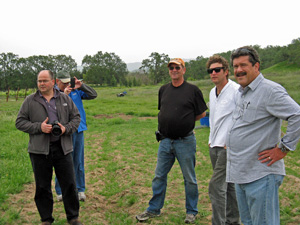
We started out with a tour of the vineyard with Mark. The weather looked threatening but rain stayed away during our walk. About 40 acres in size, Adams Ranch is located on a gently-sloping site. The area currently planted to grapevines is much smaller – about 2.5 acres of Syrah, 1.5 acres of Mourvèdre, and 1 acre of Grenache. The initial planting was in 2005, when Mark and some friends planted cuttings on their own roots. Some of the vines are head-trained while others are trellised. Mark told us that the vine spacing is mostly 3x8, though he’s now doing some high-density meter-by-meter planting. The soil is mostly not the calcareous shale found in some other parts of Paso Robles – it’s sandy in some parts of the property with more gravel and clay in others. The farming uses organic methods but is not certified, and Mark also tries to dry-farm as much as possible – he said he only had to irrigate twice in 2013, and he hopes to completely dry-farm the vineyard in the future. He’d like to plant as many as 37 of the property’s 40 acres, and will plant on selected rootstock. The yield from his own-rooted vines has not been great – they produced a total of only about five tons in 2013, an average of just one ton per acre.
Planted clones include Estrella clone Syrah and Alban clone Grenache, with some more recently-planted 814 clone Grenache that had its first harvest this year. Mark took us by a nursery area where he is getting several new grape varieties ready to plant in the near future. He’s planning to add Roussanne, Cinsault, Counoise, and Carignane to the vineyard, as well as planting more of the current varieties.
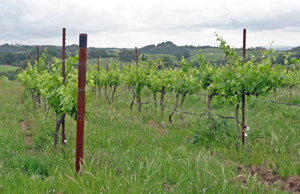
After we made the rounds of the vineyard, we walked up a hill to Mark’s house. He led us to the kitchen, where he opened a variety of bottlings from all five of his labels for us to taste. The bottlings we tried were all released within the six months prior to our visit. Ledge is Mark’s top-of-the-line label, so named because Adams Ranch is located on a relatively flat “ledge” above and just west of Vineyard Drive. Mark described the Ledge wines as more “hands-on” – showcasing vineyard sources and farming more than the other labels, which are more about the blends. Fruit for the Ledge wines is sourced from Adams Ranch and from other vineyards in the area, including James Berry, Dante Dusi, and Jada’s Messina Vineyard. The first Ledge wines came from the 2009 vintage, and Mark is now making four bottlings under that label. Mark told us that he tends to use around 50-70% whole-cluster fermentation for the Ledge wines. His wines undergo native fermentation and are typically aged in puncheons, with Ermitage, Taransaud, and Kadar being favorite coopers.
Mark’s other labels are more négociant in approach. In some cases he purchases fruit to make the wines and in some cases he buys wines already in barrel and then blends them. Wine under the Catacombs label features mainly Rhône grape varieties from Westside vineyard sources within a few miles of the estate property. The Kazoo label features both Bordeaux and Rhône varieties with more unusual blends (such as Merlot / Syrah), while California Soul includes Zinfandel as well as both typical and atypical (Tempranillo / Zinfandel / Syrah / Cinsault) blends. Most bottlings are only around 100-150 cases.

I really enjoyed our visit with Mark – it always feels a bit special when a winemaker invites you into his home to taste wines, and gathering around his kitchen island with our group was a memorable experience. I’d tasted one of Mark’s earlier wines a couple of years ago, but this was the first time I’d had the opportunity to taste through so many of them, with examples from all of his current labels. The different labels give Mark the flexibility to work with different styles, for example contrasting wines with higher alcohol and more concentration vs. lower alcohol and more elegance, as well as playing with some unconventional blends. They also allow him to work with a variety of fruit sources and aim for different price points – and it’s clear that they allow him to have some fun with the offbeat label designs too!
The Ledge wines were clearly the most “serious” of the bunch but several of the others were very nice and represent fine values. By and large, the reds are not shy wines – they still display the ripe and bold character that Paso Robles are known for – but they are less monolithic and more nuanced than many bigger Paso reds can be. The wines showed fine balance throughout the broad line-up we tasted and were quite good across the board. The Ledge 2011 Adams Ranch Syrah was my favorite of the wines we tried, though the Ledge 2012 Dusi Ranch Zinfandel, Kazoo 2012 Carignane, and Catacombs 2011 Red deserve special mention too. Mark is a man of many talents, and it should be fascinating to see where he goes with his many wine labels, and to see how his vineyard at Adams Ranch develops in the coming years.
Current releases
Catacombs 2012 Rosé, California. From saignée of co-fermented 75% Grenache, 15% Syrah, and 10% Mourvèdre, made in stainless steel. Salmon-orange color, strawberry and spice aromas. Lively mouthfeel with a fairly smooth finish.
Catacombs 2012 White, California. Around 70% Viognier and 30% Marsanne (with a tiny bit of Roussanne), made in stainless steel and neutral oak. Light straw color, this showed stone fruit, lees, and a floral note on the nose. Medium weight in the mouth, with a long, lively finish.
Kazoo 2012 Carignane, Paso Robles. 100% Carignane. Medium-dark color, featuring earth and spice upfront with raspberry fruit and sweet oak in support. Medium-bodied with bright acidity and moderately chewy tannins on the finish, nice.
Kazoo 2011 Red, Paso Robles. 50% each Merlot and Syrah. Medium purple color, with herbal cherry and plum aromas along with earth and vanilla/oak notes. Medium-full bodied with a fairly smooth texture and grippy tannic finish.
Ledge 2012 Zinfandel, Dusi Ranch, Paso Robles. From Dante Dusi Ranch, 100% Zinfandel, 50% whole-cluster fermentation, aged in new Hungarian and neutral French oak. Medium color, this displayed bright and ripe boysenberry fruit, lots of spice, and a touch of flowers on the nose. Medium weight with a bright mouthfeel and firm tannins on the long finish – nice now but should develop in the cellar too.
Ledge 2011 Syrah, Adams Ranch, Paso Robles. From Estrella clone Syrah along with small amount of Grenache, about 60% whole-cluster fermentation, aged in neutral oak. Medium-dark purple, with floral aromas along with smoky red and black fruits, a gamy note, iron, smoke, and spice – great complexity. Medium-full bodied with a lively texture and big, chalky tannins on the finish – very promising but needs more time to show its best.
Los Topos 2012 Grenache, Paso Robles. 100% Grenache, a little whole-cluster fermentation, aged in new and neutral French puncheons. Medium-light garnet color, with very bright and slightly candied strawberry aromas upfront along with touches of spice and dried herbs. Medium-bodied, finishing with big, chewy tannins.
California Soul 2012 Zinfandel, “Mother Hips,” Paso Robles. 100% Zinfandel sourced from younger Westside Paso vines, a little whole-cluster fermentation, aged in new and neutral French puncheons. Medium-dark color, this showed less “Zinny” character than the Ledge bottling, with a darker fruit profile, more earth and herbs, and lots of spice. Medium-bodied with a grippy tannic finish.
Ledge 2012 “Vineyard Drive,” Paso Robles. 48% Syrah, 25% Grenache, 25% Mourvèdre, 2% Roussanne, from James Berry and Messina vineyards, 50% whole-cluster fermentation, aged in new and neutral French oak. Medium color, featuring bright cherry and plum fruit, plenty of spice, and undertones of vanilla/oak. Medium weight on the palate with firm but not aggressive tannins.
Catacombs 2011 Red, California. 40% Grenache, 30% Syrah, 20% Mourvèdre, 7% Counoise, 3% Zinfandel, aged in new and neutral French oak. Medium-dark color, smoky bacon aromas jumped out along with plummy fruit, earth, and herbs. Medium-bodied with fairly big but fine tannins, nice.
Catacombs 2012 Red, California. 75% Grenache, 20% Zinfandel, 5% Syrah, aged in new and neutral French oak. Medium color, with strawberry and spice on the nose plus a touch of sweet oak. Medium-bodied and lively, with big, grippy tannins on the finish, needs time to settle down.
Ledge 2012 Syrah, James Berry Vineyard, Paso Robles. 100% Syrah, about 50% whole-cluster fermentation, aged in new and neutral French oak. Medium-dark color, this showed a bigger vanilla/oak component along with ripe plum and darker fruit, baking spice, and herbs. Medium-full bodied and fairly rich, with huge chewy tannins on the finish – this will certainly need bottle age to soften.
[resizeableimage=360,269]http://www.grape-nutz.com/kenz/images/27-ledge.jpg[/resizeableimage]
View of Adams Ranch with Denner Vineyard across the road
Law Wine Estates
Most of our group reassembled on Saturday morning (a couple of people headed off to do their own things for at least part of the day) and drove west from town along Peachy Canyon Road. The narrow road curves through the mountains, and it always takes longer to get from “Point A” to “Point B” than I think it will. But we’d given ourselves plenty of time and we eventually reached our first destination of the day at Law Wine Estates, where we were scheduled to meet Oliver Esparham, Law’s general manager.
After entering through the gate from the road, we headed up a hill to the winery but we were not quite sure where we were supposed to meet there – this was the first time any of us had been to the facility. We parked at the back of the winery and I called Oliver to check whether we were in the right place. It turned out that we’d gone too far, but after Oliver came out to greet us, we realized that our mistake enabled us to get a nice tour through the winery itself before ending up at the tasting room, where we were supposed to have arrived. As we made our way toward the through the winery, Oliver told us that he’d studied enology and viticulture at UC Davis and was a self-described “cellar rat” before landing at Law.
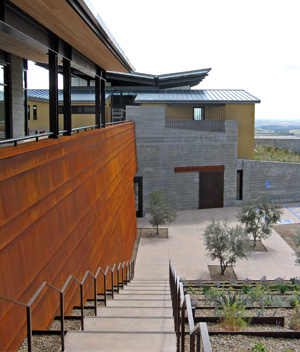
Law is a new label, with the inaugural vintage being 2010 and the winery having been completed just in time for the 2013 crush (earlier wines were made at Denner). Owners Don and Susie Law are from Colorado, and purchased their 250-acre property, which extends on both sides of Peachy Canyon Road, in 2007. The location is close to the historic HMR Vineyard, and adjacent to Daou and Glenrose. The Laws love Rhône wines and wanted to make that the focus of their new wine label, but they’re also fans of Priorat – the property reminded them of Spain – and the vineyard includes grape varieties typically found in wines from that region.
The initial vineyard plantings came in 2008, following extensive investigation of the soils – over 40 soil pits were excavated. The soil throughout much of the vineyard is high in calcium carbonate. Highly-regarded viticulturist John Crossland designed the vineyard layout, with input from both the Laws and from their winemaker Scott Hawley (who also has his own Torrin label). There are around 60 acres planted at the hilly site, at elevations ranging from about 1,600 to 1,950 feet. Varieties currently planted include Grenache (some head-trained), Syrah, Carignane, Tempranillo, Mourvèdre, plus smaller amounts of Cabernet Sauvignon, Petit Verdot, and Petite Sirah, with the Grenache and Syrah making up around 65% of the total. New plantings will include more Mourvèdre, as well as Clairette, Roussanne, and Marsanne. The vineyard is farmed organically but is not certified, and the goal is to dry-farm the site if possible.
The striking modern winery building is built into a hillside to allow for gravity flow during the winemaking process – Scott also had significant input on the winery design. The shaded crushpad is on the upper level, with fermentation tanks below. Barrel rooms and case storage are another level down, dug into the hill with concrete walls to aid in natural cooling. Other environmental features of the winery include collecting rainwater in an underground tank, and also recycling wastewater – minimizing water use is crucial these days with access to groundwater in Paso Robles becoming more difficult. The heart of the winery is the row of 22 custom-made concrete fermentation tanks, featuring heating / cooling coils embedded within the concrete. The tanks are about 3.5-ton capacity, and are designed to allow for punchdowns rather than pumpovers. There are also some 1.5 to 2 ton stainless steel fermentation tanks for smaller lots. Unlike many wineries where concrete tanks are used mainly for aging wines, the ones at Law are specifically made for fermentation only rather than aging.
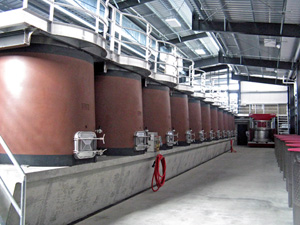
As with a number of other vineyards in the area, the fruit at Law retains good acidity even at higher brix – Oliver told us that they may pick fruit as high as 30 brix and the pH will still be in the 3.4-3.6 range. For this reason, no acid additions are needed. Efforts are being made to modify the farming to ripen the fruit at lower brix, and the Law team feels that as the vines mature, they will regulate the sugar/acid balance better. Fruit is picked at night, and is into winery before 9am and processed by early afternoon. There is a wide range of whole cluster percentages used in the fermentations, with up to 100% for some lots. There is generally a 7-10 day cold soak, then tanks are warmed up to start native yeast, with a 3-4 week fermentation period. Basket presses are used to press the wines into barrels on the lower level, and radiant floor heating warms the barrel rooms when needed to aid in malolactic fermentation. Syrahs are generally aged in barriques, with Grenache in puncheons. The Law facility had two concrete “egg” tanks when we visited, but they are planning to buy more of these as well as large wood foudres for aging the wines. Wines are barrel-aged for 20-22 months, then another year in bottle before release. The facility was built for a 10,000-case capacity, and about 80 tons of fruit were crushed there in 2013.
Our group arrived at the tasting room, a steel / concrete / glass structure at the winery’s upper level, and boasting a beautiful view of the surrounding hills. We sat at a large table as Oliver poured all of us samples of each of Law’s 2010 wines. All of the Law bottlings are made entirely with estate-grown fruit. We started with the Grenache-based “Beguiling,” followed by “Sagacious,” a GSM blend. Next was the 100% Syrah “Intrepid,” and the final wine was a Priorat-inspired blend called “Audacious.” All were big and structured for aging, with the richer “Intrepid” bottling most typical of the “big Paso style” that the area has become known for. Oliver told us that Carignane will replace Petite Sirah in the “Audacious” blend when the vines mature. The 2011 vintage Law wines have been released since our visit, and include one new bottling – a 100% Grenache called “The Nines.” The 2011 blend components are similar to the 2010s for the “Beguiling” and “Intrepid,” while there’s significantly more Mourvèdre in the 2011 “Sagacious” (34%), and the 2011 “Audacious” features more Cabernet and Syrah, with only 18% Grenache. Total production has grown from about 1,600 cases for the 2010 vintage to around 2,200 for 2011.

Our visit to Law was a memorable one – Oliver was a fine host, the tasting was set up beautifully, and the Law winery and tasting room were stunning. While the experience was more formal than our other visits – the tasting room is open to the public but is appointment-only – Oliver made us all feel relaxed and he was very knowledgeable about the wines and winemaking. The 2010 Law wines that we tasted were big – all in the neighborhood of 16% alcohol – but remarkably balanced and polished, without the “heat” that often accompanies higher-alcohol wines. And although the wines displayed lots of upfront fruit and tannic structure, their polish and refinement set them apart from many other big Paso reds. The “Intrepid” was my favorite of the four – it might have been the biggest and baddest of the bunch but it also showed great complexity despite being 100% varietal – with the “Sagacious” close behind. It should be interesting to follow the Law wines as the vineyard matures and both farming and winemaking become more dialed in. For fans of bigger Paso Robles reds, Law is certainly a producer to watch.
Current releases
Law 2010 “Beguiling,” Paso Robles. 94% Grenache, 6% Syrah. Medium-dark color, this had aromas of ripe red fruit, lots of spice, and touches of herbs and sweet oak. Medium-bodied with a moderately rich texture, this finished with chalky tannins.
Law 2010 “Sagacious,” Paso Robles. 44% Grenache, 42% Syrah, 14% Mourvèdre. Darker color, featuring both red and black fruits on the nose along with dried herbs, earth, a hint of black pepper, and plenty of spicy oak. Rich but lively mouthfeel, with bigger tannins on the finish – needs more time but quite intriguing.
Law 2010 “Intrepid,” Paso Robles. 100% Syrah, fermented in large-format French oak cooperage, aged in barriques. Very dark color, this showed more ripe black fruits, mocha, bacon, smoke, spice, and vanilla/oak. Big, rich, and structured, this had a firmly tannic finish – this has lots of upfront appeal but should benefit from time in the cellar.
Law 2010 “Audacious,” Paso Robles. 44% Grenache, 26% Cabernet Sauvignon, 20% Syrah, 10% Petit Sirah. Dark color, with upfront herbs on the nose along with dark berry fruit, spice, and sweet oak. Big and structured on the palate, with grippy tannins that will need time to settle down.
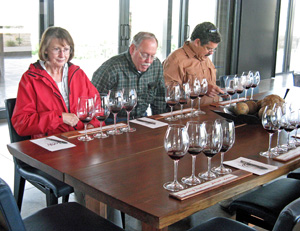

Nicora
Luna Matta Vineyard
